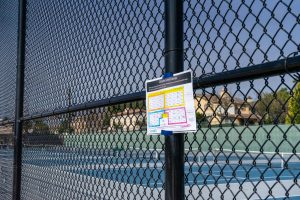One device with a pull switch is blue; another, light green.
Produced by Illinois-based BluePoint Alert Solutions, each equals the size of a 6-inch-by-7-inch red one usually seen in public places like schools and city halls to alert officials about a fire.
The difference with these is that the blue one, known as the Police Alert solution, is for anyone to activate to alert police about a life-threatening emergency, while the green one, called the Medical Alert solution, is for anyone to contact medical first responders in a health-related emergency, according to the BluePoint website, bluepointalert.com.
Fullerton Joint Union High School District [FJUHSD] director of safety and risk management Christopher Davis told trustees in a Sept. 9 meeting that the addition of each alarm should have been installed on all campuses — including Sunny Hills — in January.
But two months later in March, they are nowhere to be seen.
“School and FJUHSD officials are installing this system in either the hallway near the current fire alarm in Room 4 or the hallway outside of assistant principal Heather Bradley’s office in Room 6,” said principal Craig Weinreich, adding that district officials recently came to campus to consider where to install the gadgets. “No specific time frame has been set for when the device will be installed [during this school year].”
The BluePoint emergency system, patented in 2016, is used in schools, corporations, places of worship and more throughout 19 states, according to the BluePoint website.
It’s one of the many unprecedented changes that the FJUHSD has implemented for its campuses this school year in response to superintendent Steve McLaughlin’s focus on school safety.
Along with this alert system, other major updates include staff being required to wear district ID badges while walking around campus and new signage getting posted in the office wing from rooms 1-7. District officials have also recommended updating emergency supplies to be stored in a new container and adding a new protocol during disaster drills to ensure safety for all.
WHY THESE CHANGES?
The state requirement that all public schools must create and make available to the public its protocols for dealing with such possible dangers as fires, earthquakes or intruders – also known as the comprehensive school safety plan – was presented in Senate Bill [SB] 187, which was approved by then-Gov. Pete Wilson and signed into law in 1997.
Though recent laws adding to the plan were signed by Gov. Gavin Newsom in 2023, assistant principal and head of the SH safety committee Heather Bradley said the new changes are not related to the legislation. In fact, the FJUHSD has been going above the scope of these laws.
“We have had most of these practices in place for years,” Bradley wrote in an email interview with The Accolade.
The updated mandates, which took effect on Jan. 1, require changes to already existing school safety plans:
- SB 10, a response to the fentanyl crisis in schools, requires plans to include a protocol for responding to a student’s opioid overdose.
- SB 323 requires that comprehensive school safety plans address accommodations related to relevant federal disability laws and requires that the annual evaluation of those plans ensures appropriate adaptations to school safety practices are in place for students with disabilities.
- SB 671 requires schools’ safety plans to include procedures to assess and respond to reports of any dangerous, violent or unlawful activity conducted at the school or at an activity sponsored by the school.
Regarding SB 10, Bradley said since the previous school year, the district has provided campuses with Narcan, a medicine that reverses an opioid overdose.
In addition, the assistant principal said one of the reasons the school conducts drills is to make sure students with disabilities are considered in an emergency, which covers SB 323.
Finally, she said the school has several measures in place to comply with SB 671, ranging from the StopIt! app for reporting potential issues to the visibility of campus supervisors.
A condensed version of the SH safety plan is in the Student Handbook, but Bradley said the public can contact her at hb[email protected] for the whole thing, which is also a state Education Code requirement for it to be available for viewing.
SIGNAGE AND STAFF BADGES
One of the changes to the SH campus is more informational labels, which can be found in the offices and near the entrance of the school.
A large sign, the size of “No Parking Anytime” one in the campus parking lot, drilled near the entrance of the school states, “Visitors are required to check in with our administration upon entering campus.”
Students can also spot similar signs reading, “Authorized personnel only beyond this point” in rooms 4, 6 and 7.
Along with these additions, SH staff members are required to wear a “sign” identifying themselves as faculty, as wearing district ID badges is now mandatory.
The badges that teachers and staff started wearing are similar to what employees wear in a corporate office like Google or neighboring Raytheon.
“I think the campus signs are helpful to staff and students,” said English teacher Christina Zubko, who’s on the SH safety committee. “Students should never go behind the partition as there is confidential information about other students that might be displayed on a desktop; also, these signs protect staff from visitors going behind the partition.”
THE CONTRACT WITH ICS4SCHOOLS
In the Sept. 9 Fullerton Joint Union High School District [FJUHSD] board meeting, assistant superintendent of business services Ruben Hernandez and Davis introduced the five safety focus areas of the FJUHSD: safety plans, partners, resources, safety drills and communication.
Going along with the “safety plans” pillar, Davis said the district has contracted for an unspecified amount of money with ICS4Schools, based in California, after it shifted to the Incident Command System [ICS] model, one that is used by first responders, and introduced ICS safety plans to staff during a training at the beginning of the 2023-2024 school year.
This shift is important because this model allows for effective communication with firefighters and police.
ICS4Schools offers a unique safety system to schools to help prepare sites with an effective and organized emergency response protocol and serves with a mission to keep schools safe.
The company’s services include initial hazard assessment, identifying possible breech areas of concern and providing emergency supply kits and backpacks for classrooms.
An email was sent to Davis for an additional interview about changes at Sunny Hills, but he only advised to watch his presentation at the September district board meeting, which is available for viewing on YouTube.
STUDENTS GATHER WITH GRADE DURING DRILLS
Bradley said the biggest change in terms of drills across all district campuses is the new method of student division in the emergency evacuation area, a change that resulted from the district’s contract with ICS4Schools.
First implemented during the Feb. 15 fire drill, students were divided into grade levels after meeting with their second period teachers like they have done in the past at the evacuation area – the outdoor basketball or tennis courts. For example, freshmen met on tennis courts 1-5. Sophomores gathered on the other half of the tennis courts. Juniors were to congregate across the freshman on the opposite side of the gate, while seniors got together opposite the sophomores beyond the division.

In the case of an actual emergency, each grade area will have a lead teacher with a walkie-talkie to communicate with administrators at the pick-up point, up Lancer Way, where parents will wait to reunite with students inside the baseball field, Bradley said.
“I actually thought that the drill [with the change] went really smoothly,” Bradley said. “All of the students listened well and moved quickly to where they were supposed to go.”
The administrator acknowledged one area that needed improvement.
“I definitely need a better announcement system,” said Bradley, who used a bullhorn to announce the initiation of the grade level groupings leading to teachers having to spread the word about it.
Students have practiced this procedure for a second time on Thursday with police and firefighters also expected to participate in the drill.
To fulfill her role as the head of the safety committee for the second year, Bradley said she’s in charge of scheduling and looking over security procedures on campus and making any necessary changes.
Following each drill, a safety committee meeting is held, in which campus supervisors, teachers, Davis, Fullerton Police school resource officer Gene Valencia, teachers and members of the Parent Teacher Student Association attend, she said. At these meetings that usually have 8-10 people in attendance, the administrator works to obtain feedback on the drills.
“We’ve always had emergency evacuation procedures in place — our teachers and students do a great job of implementing all of these procedures when we do the practices,” Bradley said. “But there’s always room for improvement, so we’re open to trying these new suggestions and seeing how things go and then making any changes necessary based on what we see.”
Although she agreed with the assistant principal about how the drill was conducted, math teacher Amanda Shaw said one issue she noticed was the cluster of students trying to get in or out of the tennis courts to their grade level groups.
“When the juniors and the seniors exit the tennis courts, and then the freshmen and the sophomores have to enter, there’s a lot of bottlenecking at the gates, and I don’t think that’s really a good thing.” said Shaw, who is part of the first-aid team.

Regarding the crowding at the gates, Bradley said SH administrators are communicating with the district to possibly change the single-entry gates into double-entry ones.
Though her initial reaction to the new drill procedure was filled with a little doubt because of the aspect of chaos, junior Gianna Garcia said her experience was different than what she had expected.
“I thought that the new way of organizing for the drill was fine; I had imagined that it was going to be far more hectic,” Garcia said. “I’m OK with the changes after finding out by my teachers that this would help in a real life situation to make the pick-up process easier.”
Sophomore Aaron Green said he enjoyed dividing into grade levels because he did not have to stay with his second period class.
“In the beginning, people were confused and asking questions about where to go, but after a bit everyone figured it out, and it was chill,” Green said.
NEW AND IMPROVED EMERGENCY SUPPLIES
Bradley said locked bins, which can only be accessed by administration and custodians in an emergency, filled with safety and emergency supplies such as food and water are now located outside the weight room.
The supplies were in place before the contract with ICS4Schools, but they have been updated with search and rescue materials and enough food and water to last students a couple of days, the assistant principal said.
Garcia said the bins filled with safety supplies was a good call.
“I think that it is really good to implement that in our school, just knowing that there’s a bin that can also help in certain occasions,” the junior said.
Like Garcia, sophomore Scott Lee is in favor of this addition.
“Emergency supplies are always important to keep, even if an emergency on campus is not very likely,” Lee said.
Bradley said the changes are leading Sunny Hills in a positive direction when it comes to safety.
“I think the areas that ICS4Schools is changing are areas that we don’t always get to practice, like the parent pick-up after an emergency occurs,” she said. “So we’re trusting that this company, who does have prior experience with these things, is giving us good feedback that will help us in the future.”







![Students and staff across the Fullerton Joint Union High School District [FJUHSD] received emails promoting a part time job offer with pay. The messages were set from compromised FJUHSD accounts.](https://shhsaccolade.com/wp-content/uploads/2025/09/image1-2-1200x527.png)






